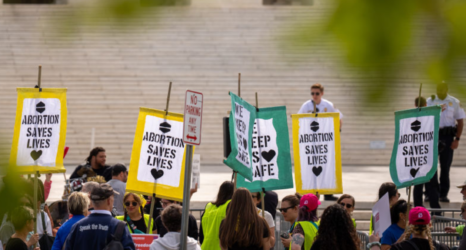The opinion will have wide-ranging consequences not just for abortion access and women’s health—but for rights like access to contraception, infertility treatments and sexual privacy.

The Supreme Court has overturned Roe v. Wade.
In a cruel betrayal of the women of this country, and for the first time in the history of the Supreme Court and the United States, a fundamental constitutional right has been taken away.
This decision was expected—but that does not change its devastating impact. As of Friday morning, the trigger laws that ban abortion from the moment of fertilization on the books in thirteen states have begun to go into effect—as have the trigger laws that ban abortion after six and 15 weeks of pregnancy on the books in five additional states. Eleven states’ bans have no exceptions for cases of rape or incest, and six states have no exceptions for the health of the pregnant woman.
The impact of this ruling cannot be overstated. The opinion is all but guaranteed to have wide-ranging consequences not only for abortion access and women’s health, but for many other rights, including access to contraception, infertility treatments and sexual privacy.
In a concurring opinion Justice Clarence Thomas writes that going forward the Court must “reconsider all of this Court’s substantive due process precedents.” The conservative Justice names Griswold v. Connecticut (which secured birth control access), Lawrence v. Texas (which overturned sodomy laws), and Obergefell v. Hodges (which secured same sex marriage) among the precedents that should be “reconsidered.”
In the Court’s opinion, which closely follows the draft opinion leaked to Politico in May, Justice Alito maintains that Roe was “egregiously wrong.” We know that the historical record ultimately will show that Alito, as well as those who voted with him to overturn Roe, including Clarence Thomas, Neil Gorsuch, Brett Kavanaugh and Amy Coney Barrett, were in fact the ones who got it egregiously wrong.
While over half the country will now ban abortion, we know that this decision will not stop people from seeking abortions. There is a robust network of organizations and funds that exist to help abortion seekers access abortion pills online, and use them safely — no matter what a state’s law says. Attorney General Merrick Garland has made it clear that states cannot ban abortion pills on federal preemption grounds. “The FDA has approved the use of the medication Mifepristone,” he said in a statement Friday. “States may not ban Mifepristone based on disagreement with the FDA’s expert judgment about its safety and efficacy.”
We also applaud the Biden administration’s multi-faceted response to this crisis. The President has directed the department of Health and Human Services to ensure that medication abortion and birth control are available “to the fullest extent possible,” and to protect the right to travel to another state for an abortion. “The health and life of women of our nation are now at risk,” the President said. “Make no mistake. This decision is the culmination of a deliberate effort over decades to upset the balance of our law.”
We agree with President Biden: this fight is not over, and the rights of women and people to make their own decisions about abortion, contraception, and the right to privacy, including same sex marriage, will be on the ballot this November.
As we move forward into the uncertain future, we will continue to bring you news from the front lines of the fight for our reproductive rights. We reaffirm our commitment to you: we will not stay silent, we will not go back, and we will help construct a way forward.
Read more:





